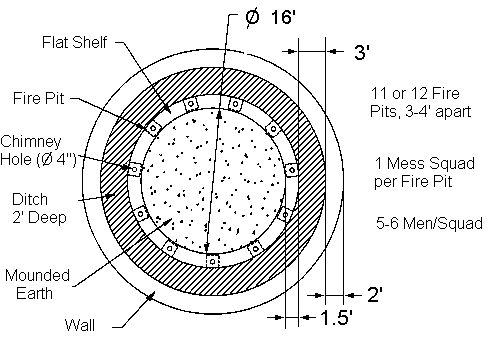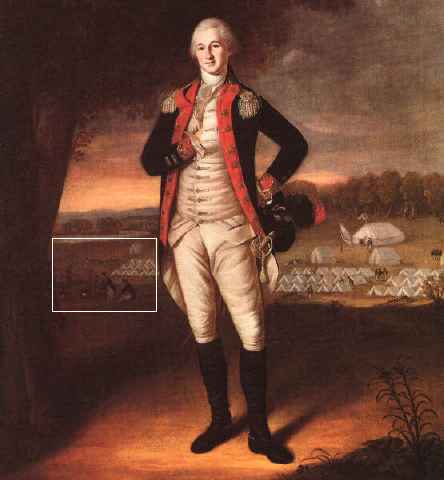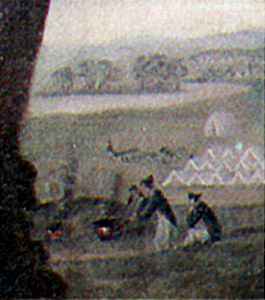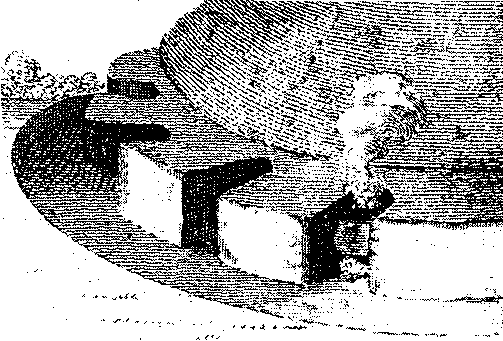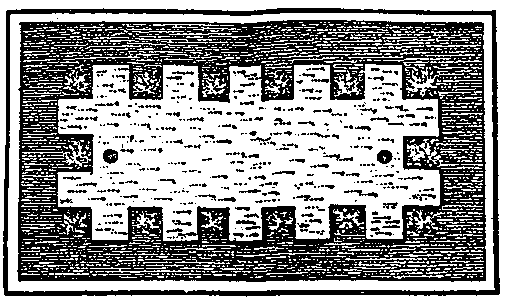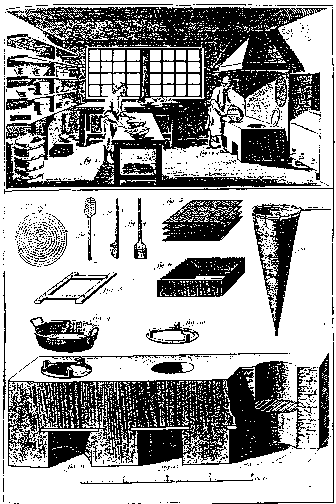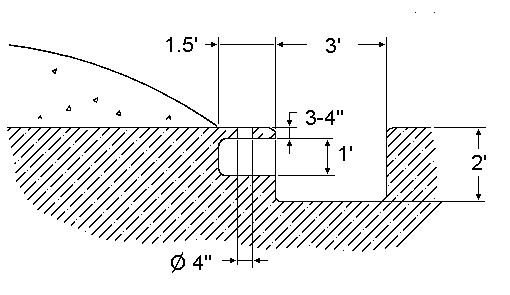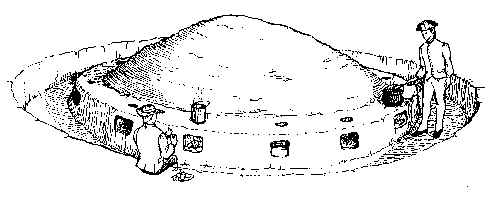(Originally published in Food History News, vol. IX, no. 2 (Winter 1997),
2, 8-9; vol. IX, no. 3 (Spring1998), 2, and The Continental Soldier,
vol. XI, no. 3 (Summer 1998), 26-32.)
Part I
“Cooking Excavations”
Their History and Use by Soldiers in North AmericaFor soldiers, building a fire meant the difference between merely eating to fill an empty belly and the satisfaction of a warm, nourishing meal. Without cooking fires during a prolonged rainstorm at Brooklyn in August 1776, Captain Alexander Graydon was forced to eat his salt pork uncooked. An exhausted Joseph Martin, after serving in Fort Mifflin's garrison during the grueling November 1777 siege, evacuated the fort with his company, crossed the Delaware River and halted briefly after receiving "a day's ration of salt pork... and a pound of sea bread." With little time available "We kindled some fires in the road, and some broiled their meat ... I ate mine raw. We quickly started on and marched till evening ..." Staples such as soft bread or newly-baked biscuit needed no preparation to be eaten, but seasoned hard bread had to be softened by boiling and rations of meat, flour, rice, and vegetables were more toothsome if cooked.1
Open fires, built quickly and often abandoned soon after they served their purpose, were the usual medium for meal preparation. When time and location allowed, the army also employed large temporary kitchens (round or square) dug into the ground. Humphrey Bland gave detailed instructions for building an earthen kitchen in his 1762 Treatise of Military Discipline. His was a circular construction with a 16 foot-wide mound in the center, a 1 1/2 foot shelf around that, all encircled by a ditch 3 feet wide by 2 feet deep. This kitchen could accommodate 11 or 12 fireplaces, each consisting of a 1-foot-square firebox dug into the inside wall of the surrounding trench and a chimney hole “of four inches diameter” through the shelf above. With a fire underneath, the “heat [was] conveyed through those small holes to the bottom of the kettles, which are placed on top of them.”2
Overhead view of earthen kitchen, with dimensions given in
Humphrey Bland's 1762 specifications. (Illustration by Ross Hamel.)According to Bennett Cuthbertson, author of a System for the Compleat Interior Management and Oeconomy of a Battalion of Infantry (1768), “the allied Army in Germany last war” (i.e., the Seven Years War, 1756-1763) used circular kitchens similar to the one described by Bland. During the War for Independence the Continental Army also built them, though how often is not known. The Regulations for the Order and Discipline of the Troops of the United States Part I. published in 1779 (Friedrich de Steuben, Philadelphia, Pa., p. 79) gives the following description of a battalion cooking area: “The kitchens are to be dug behind their respective companies, forty feet from the field officers tents. The sutlers tents are to be between the kitchens.” This mirrors Humphrey Bland’s reference to “The circles ... drawn in the plan [of a camp] between the grand and petty sutlers, [which] are marked for kitchens, or places where the private men are to dress their victuals ...” As in Bland’s 1762 Treatise, Steuben’s illustration of a camp (viewed from above) shows circular cooking areas, an indication that as early as 1779 earthen kitchens were being depicted and occasionally used.3
Several other sources allude to excavated kitchens as well. For example, 19 July 1779 orders for the 1st Pennsylvania Regiment directed “The Quarter Master to see the vaults [i.e., latrines] sunk as soon as Possible, and to have Kitchens sunk [i.e., dug] in the frount for the soldiers to Cook in, and some to the Right for the officers waiter’s to Cook in. The soldiers to have no fire But what is in the Kitchens.” Charles Willson Peale’s portrait of Colonel Walter Stewart (2nd Pennsylvania Regiment), painted during or just after the war, shows a camp complete with lines of tents and soldiers cooking on a circular kitchen.4
(Above and below) Continental Army encampment with camp kitchen excavation, from C.W. Peale portrait of Pennsylvania Colonel Walter Stewart. The pictured camp was likely sketched in spring 1781 when the Pennsylvania regiments were stationed in Lancaster, Pa. (Peale’s bill for the camp sketch was dated 23 May 1781). Edward W. Richardson, Standards and Colors of the American Revolution (Philadelphia, Pa., 1982), 219.
Since these kitchens were a European innovation, French, British and German troops must have used them often. In what seems to be a reference to earthen kitchens, Chaplain Johann Waldeck, of the German Waldeck Regiment, noted the situation soon after his arrival at Pensacola, Florida: “21-29 January [1779] - In the city absolutely no preparations have been made for quartering the troops. Also no kitchens set up where the troops can prepare their food, and only now the soldiers have been ordered to begin work on the cooking excavations.” Captain Samuel Richards, 3rd Connecticut Regiment, observed the French Army in June 1781,
Rochambeau with his five thousand soon moved on: as they passed thro' Farmington in Connecticut I being there at the time - had a fine opportunity of seeing them ... I viewed their manner of encamping over night, the perfect mechanical manner of performing all they had to do: such as diging a circular hole & making nitches in which to set their camp kettles for cooking their food ...5The French forces were in the area for only three day, from the 25th to the 28th.
Detail of alternate kitchen fireplace construction. Close study of the cooking excavation in C.W. Peale's portrait of Colonel Stewart suggests that at least some dug by the Continental Army had enclosed fireplaces (Grose Military Antiquities, Peterson 155; Richardson 218).
Two publications, one English, the other German, show a variation of kitchen fireplace construction. Francis Grose’s Military Antiquities. Respecting a History of the British Army (London, 1801) shows a woman cooking at a kitchen, the fireplaces of which are open niches dug out to the bottom of the surrounding trench. A 1788 German military manual, Was ist jedem Officier wahrend eines Feldzugs zu wiffen nothig. Mit zehen Kupferplatten. (trans., “What it is necessary for each officer to know during a campaign”) (Carlsruhe), shows two similar firepits with camp kettles suspended from sticks placed across the top of the excavations. This publication also shows a square earthen kitchen.6
Three examples of soldier's cooking fires. Plate 3is the most recognizable, being a simple arrangement of forked sticks holding a cross-member from which kettles were hung. Plate 2 seems to show a pit sunk into the ground, with a fire pit at the bottom, and a kettle hung from the top. The firepit atin plate 4 is made in a raised mound of dirt, similar to the fireplaces in an earthen kitchen (Was ist jedem Officer).
Overhead view of a square earthen kitchen. Unlike the closed fireboxes described by Bland, this example seems to have open niches with fires at the bottom; kettles could have been hung overhead from cross-bars or set directly on the fire. Was ist jedem Officier waehrend eines Feldzugs zu wissen noethig (trans., "What it is necessary for each officer to know during a campaign") (Carlsruhe, 1788) Mit zehen Kupferplatten ("with ten copper plates"), plan 3.
Advantages
Humphrey Bland extolled the advantages of “cooking excavations” for the soldiers. Chief among the benefits was the ability to cook in the rain, the lessening “of accidents by the fire’s being blown amongst the tents or forage,” easing the officers’ task of overseeing food preparation, and that “very little fuel will serve to dress their victuals.” These last two points merit further discussion.
Officers’ must have greatly appreciated having all the cooking kettles concentrated at a single location. Bland noted, “if you erect one of these kitchens (by which I mean an entire circle or square) for each troop or company, they need not be larger than what will contain as many fireplaces as you have tents... for as all the men who lie in a tent, are of one mess, every mess must therefore have a fire place, that they may have no excuse for their not boiling the pot every day.” In conjunction with these points, “the Officers can, with a great deal of ease, look into the conduct and oeconomy of their men” when preparing food. Again, Steuben’s 1779 Regulations echo Bland: “... an officer of a company must often visit the messes; see that the provision is good and well cooked; that the men of one tent mess together; and that the provision is not sold or disposed of for liquor."7
Even more important was a kitchen's fuel efficiency. Economy of fuel was essential in many areas of Europe, but even in the heavily wooded countryside of North America such a savings had benefits. Wood for cooking or warmth was a daily necessity for the troops, the cutting and hauling of which required much labor. Orders for General Nathanael Greene's Division, Germantown, Pennsylvania, 1 August 1777, state that "The Quarter Masters of each Regiment are directed to see the Men are provided with wood for Cooking, the Quarter Master Genl. of each division will direct the Regimental Quarter Masters where to cut wood." Army orders, Skippack, Pennsylvania, 30 September 1777, direct that "One hundred and fifty ax-men, from Genl. Sullivan's, Greene's, Lord Stirling's and Stephen's divisions, and Genl. Nash's brigade, are to be selected this day, and a like proportion from the other brigades. These men are always to carry their axes with them ... [besides building roads and fortifications] they are to cut firewood for their respective brigades." 8
Wood may have been plentiful, but not all of it was available. Several orders attest to this. "Head Quarters, New York, May 5, 1776 ... The Officers commanding the Guards, in and near the encampment, are to be particularly attentive to prevent any waste or depradation, being committed upon the Fields, Fences, Trees, or Buildings about the camp ... any non-commissioned Officer, or Soldier, who is detected cutting any of the Trees, or Shrubs, or destroying any of the Fences, near the camp, will be confined, and tried for disobedience of orders." From Pompton, New Jersey, 25 July 1777, "The troops having arrived at the place of encamping so early, they can with the greatest ease provide themselves with wood; and each Brigadier General will see that it be done accordingly - That fences are ever burnt must be imputed to inattention, and want of care in officers ..." Just prior to the army's departure from Valley Forge in June 1778, General Nathanael Greene appointed several men to look into any damage the troops may have caused, including "Destruction of Fences, or Timber."9
Equipment shortages exacerbated the need for fuel conservation. Although each mess squad was supposed to be issued a tomahawk or hatchet, and each company a few axes, wood cutting tools were sometimes unavailable, in short supply, or in poor condition. At Whitemarsh, Pennsylvania, Sergeant Ebenezer Wild noted on 7 December 1777 that his company "had no axes to cut wood for fires nor covering."10
Military earthen kitchens had a civilian counterpart from which they probably descended. In Savoring the Past: The French Kitchen and Table from 1300 to 1789, Barbara Ketcham Wheaton noted that masonry potagers became common in French kitchens during the 17th and 18th centuries. These appurtenances were built in the same manner as the fireplaces of an earthen kitchen, having a firepit under a shelf through which a hole was made to direct the heat. Instead of being dug into the ground, a potager was built above the kitchen's floor, also allowing the cook to stand while tending the pot. (The kitchen of the Governor's Palace at Colonial Williamsburg has several potagers.)11
The civilian masonry potager (pronounced poe-ta-shay) was the likely forerunner of the military earthen kitchen combination of shelved trenches with cut-in fireboxes. Barbara Ketcham Wheaton writes, "By the beginning of the seventeenth century [in France] ... even the female cook was no longer dependent on her fireplace alone, for with a little luck her kitchen might be fitted with a brick potager, 'a slightly raised place where one prepares soups, or where there are several little charcoal stoves on which they are simmered.' ... The relative comfort and convenience of raised stoves [i.e., potagers] should not be underestimated. It would have been miserable to work for long hours year-round at a blazing hearth. In comparison, the less intense heat and the chance to work standing up ... would have encouraged the cook to pay closer attention to the fine points of his or her art." Barbara Ketcham Wheaton, Savoring the Past: The French Kitchen and Table from 1300 to 1789 (Philadelphia, Pa., 1983), 101, 107, 109.
Digging a Field Kitchen
Two Virginia historical sites have kitchen excavations. Yorktown Victory Center's earthen kitchen (the fourth on site) was built entirely by manual labor in 1995. Used regularly by the staff, the current example was made of sandy soil purposely mixed with clay to enhance longevity. Colonial Williamsburg's military camp has also incorporated earthen kitchens; the camp is currently in the process of being relocated, and another kitchen is planned for the new site.12
Earthen kitchens were an elegantly simple solution to a number of problems, but required a good deal of labor. Under ideal conditions soldiers could construct a full kitchen in a single day, depending upon the nature of the soil at the chosen site, and whether there were conflicting demands for labor. Stephen Gilbert related constructing a single fire pit (trench section, firebox, and chimney) with another man, noting that the endeavor required about an hour's worth of digging. Justin Grabowski noted that the kitchen trench built in 1995 at Yorktown Victory Center took four men about four hours (16 man-hours) to excavate "through clay, roots and rock," using only mattock and shovel. After that was completed, approximately 30 to 45 minutes was required to dig out a single firebox and chimney. (It must be noted that the trench of this kitchen seems not to have been dug to the proper depth, lessening the time for digging but making it difficult to build and tend the fires.)13
Cutaway view of earthen kitchen (shelf, ditch and fireplace).
The chimney hole should be set back from the edge of the ditch
about 10 to 11 inches; depth of fireplace from 16 to 18 inches.
(Illustration by Ross Hamel.)Three connecting firepits dug by myself and Matthew Murphy at Bordentown, New Jersey, in June 1997 required about 3 man-hours each, with the soil composed largely of clay and small stones, very difficult digging indeed. This experience agrees with that of John Hill, who noted that the last complete kitchen dug at Colonial Williamsburg's military camp took approximately 36 man-hours to finish (i.e, 12 firepits at 3 hours each).14
Because of the insights available through hands-on experience, reconstructing an earthen kitchen is well worth the effort, despite the prodigious amount of labor required (admittedly one commodity plentiful in armies). Those few who have cooked on the excavations at Yorktown Victory Center, Colonial Williamsburg, and itinerant kitchens like the one at Bordentown, have had a rare opportunity, enabling them to confirm (or deny) the simplicity and efficacy of the design.
Part II
Complete 1762 Kitchen Description and Winter Covering for Field KitchensBelow is the earthen kitchen description and dimensions given in Humphrey Bland’s Treatise of Military Discipline (London, 1762, 288-290):
... the inner diameter [of each earthen kitchen] is sixteen feet; the breadth of the trench surrounding them, is three feet; the seat is one foot and a half; and the breadth of the outside wall two feet; which makes the outer diameter twenty-nine feet ... The circles which are drawn in the plan [of a camp] between the grand and petty sutlers, are marked for kitchens, or places where the private men are to dress their victuals ... [The trench dug around the circumference of the circle is to be] three feet broad, and two deep ... When this is done, you are to cut holes or niches in the side of the circle or square of earth which is left standing within the ditch. These holes may be about a foot square, the upper part of which should be within three or four inches of the surface, from whence they are to cut small holes of four inches diameter, down to the great ones, in which the fire is to be made, and the heat conveyed through those small holes to the bottom of the kettles, which are placed on top of them. These fireplaces may be made within three or four feet of one another quite round the said circle or square [either 11 or 12 fireplaces to one earthen kitchen].; and if you erect one of these kitchens (by which I mean an entire circle or square) for each troop or company, they need not be larger than what will contain as many fireplaces as you have tents ... for as all the men who lie in a tent, are of one mess, every mess must therefore have a fire place, that they may have no excuse for their not boiling the pot every day.
These kitchens were used in winter camps, too. It was common for soldiers on both sides during the Revolution to build various types of brush shelters (in fact, this was done more often by the British army when campaigning than by American troops). A structure similar to soldiers' wigwams or brush huts was recommended for building over camp kitchens in cold weather. When …
a Regiment is to remain very late in the Field ... [it] will require many ... precautions to make the Soldiers comfortable ... in particular during the time of cooking, when the inclemency of the weather often renders it almost impracticable, in the open air; to obviate ... the distress, to which they must at that juncture be exposed, young trees should be collected, about the size and length of hop-poles, and placed in a circular form round the out-side of the Kitchens, sloping upwards to a point, exactly in the same position, the poles are fixed ... leaving a sufficient opening on one side, for the men to enter, and weaving small boughs or rushes through the poles: the Kitchens being defended in this manner, the Soldiers remain no longer exposed to the inconveniences of the weather; and are enabled, not only to dress their victuals, without the smallest interruption, but by making a large fire in the center of the Kitchen, to enjoy themselves in great comfort and satisfaction ... (Bennett Cuthbertson, System for the Compleat Interior Management and Oeconomy of a Battalion of Infantry (Dublin, 1768), 40-41.)
Valley Forge National Historical Park has discovered at least three original dug kitchens at the Pennsylvania Division cantonment site. It is not known if those kitchens were dug in the winter months; if they were, it is possible they were provided with coverings like those described above.
Part III
Matt and I Dig a KitchenThe long-considered idea of digging an earthen kitchen finally came to fruition in June 1997 at a large living history encampment in Bordentown, New Jersey. The excavation could count on only one laborer, myself, as our group was hosting the event and other work needed to be done. This, and the fact that it had to be completed in a single day, led me to attempt digging three firepits (1/4 of a full-sized kitchen), using only tools available to 18th century soldiers.
... the inner diameter is sixteen feet; the breadth of the trench surrounding them, is three feet; the seat [on the inside of the trench] is one foot and a half; and the breadth of the outside wall two feet; which makes the outer diameter twenty-nine feet ... (Humphrey Bland, Treatise of Military Discipline (1762))
June 6, 1997, 8:00 AM: Before any digging could be done, the kitchen's outline had to be marked on the ground. This was accomplished by first sinking an iron tent pin in the center of the chosen site and attaching a length of rope with knots tied at three pre-measured points as per Bland's dimensions; taking a bag of powdered lime, and scooping out a handful, I placed the lime-filled hand at the first knot, pulled the rope taut, and walked the entire circumference, dropping lime to trace a line as I went; this was repeated for each remaining knot. In this manner the inner mound, and the inside and outside of the trench were marked, ready to excavate.

Since the kitchen excavation had to be filled in at the end of the weekend, I began by removing the sod from the outlined trench; this was placed on the outside of the trench to form the outer seat, the sod making a pleasant sitting and working surface. (This was done for half the kitchen circumference, in case some hardy soul wanted to try his hand at digging a fireplace over the weekend.)
10:00 AM to 4:30 PM: After a brief rest period, I commenced digging a 10 1/2 foot section of trench (outside measurement), sufficient for three firepits. About 12:30 PM Matt Murphy, a member of the same recreated regiment, offered to join me in the effort; misery loving company, I welcomed him gladly. By 1:30 the first firepit was ready to use, complete with firebox and chimney hole. With Matt's continued help the third and final firepit was finished around 4:30 PM. (Approximately 3 man-hours were used for each firepit.)

Several insights were gained through this enterprise.
Construction: To begin with, only one man at a time could safely work on a three-foot-wide firepit section. The digging was done by alternately plying pick and shovel; the finishing work on the trench and firebox was done with shovel and spade. Partially abrogating my original intent, a modern sod cutter with a 4-inch blade proved the perfect tool for cutting the firebox chimneys (a simple iron pry bar may also work for the job). The chimney holes were cut above the firebox, 10 to 11 inches from the edge of the trench. Each firebox was dug in from its 1-foot-square opening to a depth of 16 to 17 inches.
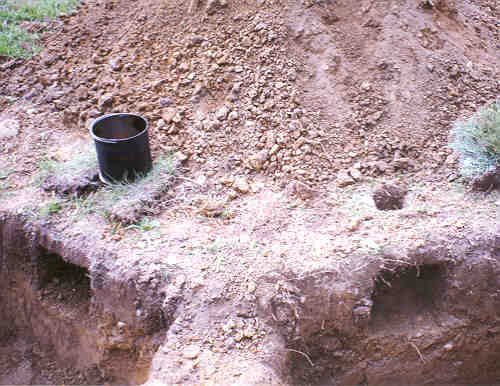
Firekeeping: A camp kettle placed directly on top of the chimney hole reduces the draught. Laying a piece of sod to either side of the hole prevents this, serving to raise the kettle and allow free airflow. Squares of sod can also be used to cover the chimney holes when not in use, holding sparks in and keeping rain water out.
Camp kitchen in use. The tin or sheet iron kettles commonly
used by armies in North America would be placed on two pieces
of sod to allow the draught of the fireplace to escape
through the chimney hole. Barrel-hoop "broilers" constructed
by the soldiers may also have been used for that purpose.
(Illustration by Ross Hamel.)
[Additional photos, and period prints are available Here]Cooking: Having little time available for experimentation, I only prepared a simple soldier's meal: beef, carrots, and biscuit, boiled in a sheet-iron kettle. I hope in the future to gain experience with soup, stew, pease-porridge, milk porridge, hasty pudding, suppawn, and other dishes cooked by soldiers.
... as the fire-places are open at the side, like the mouth of an oven, the air which enters there forces all the heat up the small hole to the bottom of the kettle, and consequently boils it very soon; and as the kettle covers the said hole, the rain cannot come to extinguish it, or create the men any trouble in keeping it in. (Humphrey Bland, Treatise of Military Discipline (1762))
Building the kitchen was a rewarding experience, made all the more so by having it used to good effect and viewed with interest by those previously unfamiliar with one. The people who cooked on it over the weekend remarked on several points agreeing with Humphrey Bland's assessments: how quickly kettles heated using less fuel, the ease of earthen kitchen cooking compared to working with an open fire on the ground, and the convenience of the seat/working surface provided by the kitchen's outer shelf.
In addition to introducing people to cooking excavations and their use, building the kitchen also worked is an exercise in living history, and showed what can be accomplished in a short time, given the proper setting, and much-needed support.
Acknowledgments
My thanks to the following people who helped in various stages of kitchen construction and research: Matthew Murphy, Chuck Beale, Stephen Gilbert, Sandra Oliver, Justin Grabowski of Yorktown Victory Center, and John Hill and Pat Gibbs of Colonial Williamsburg. Special thanks go to Paul Hutchins and Drew Smith for their encouragement with the Bordentown project. My appreciation also to James Casco (Whitcomb's Rangers), Nancy Pecca (2nd New Jersey Regiment), Susan Plaisted (German Regiment), David Wilson (2nd Massachusetts Regiment), and others whose names I cannot recall who either cooked on the kitchen at Bordentown or stopped by, voicing support and posing questions.
Footnotes
1. Alexander Graydon, Memoirs of My Own Times (Philadelphia, Pa., 1846), p. 165. Joseph Plumb Martin, Private Yankee Doodle: A Narrative of Some of the Adventures. Dangers and Sufferings of a Revolutionary Soldier (New York, N.Y., 1962), pp. 97-98.
2. Humphrey Bland's Treatise of Military Discipline (London 1762 pp 288-290 (henceforth cited as Bland, Treatise of Military Discipline).
3. Bennett Cuthbertson, System for the Compleat Interior Management and Oeeonomy of a Battalion of Infantry (Dublin, 1768), pp. 40-41. Bland, Treatise of Military Discipline p. 288.
4. Regimental Orders, 26 May 1779, The Orderly Book of the First Pennsylvania Regiment, Col. James Chambers, 23 May 1779 to 25 August 1779, John B. Linn and William H. Egle, eds., Pennsylvania in the War of the Revolution. Battalions and Line. 1775-1783, II (Harrisburg, Pa., 1880), pp. 468-469. Edward W. Richardson, Standards and Colors of the American Revolution (Philadelphia, Pa., 1982), p. 218 (the earthen kitchen in Peale's painting can be seen in the background, to the left of Colonel Stewart).
5. Bruce E. Burgoyne, Enemy Views: The American Revolutionary War as Recorded by the Hessian Participants (Bowie, Md., 1996), p. 309. Samuel Richards, Diary of Samuel Richards. Captain of Connecticut Line War of the Revolution 1775-1781" (Published by his Great-Grandson. Philadelphia, 1909), 74-75.
6. Kitchen illustration from Francis Grose, Military Antiquities, Respecting a History of he British Army (London, 1801), pictured in Harold L. Peterson, The Book of the Continental Soldier (Harrisburg, Pa.: Stackpole Books, 1968) 155. Was ist jedem Officier waehrend eines Feldzugs zu wissen noethig (trans., "What it is necessary for each officer to know during a campaign") (Carlsruhe, 1788) Mit zehen Kupferplatten ("with ten copper plates"), plan 3.
7. Bland, Treatise of Military Discipline, pp. 290-291. Friedrich de Steuben, Regulations for the Order and Discipline of the Troops of the United States Part I. (Philadelphia, Pa., 1779), pp. 83-84.
8. Richard K. Showman, ed., The Papers of General Nathanael Greene, vol. II (Chapel Hill, N.C., 1980), pp. 131-132. General orders, 30 September 1777, John C. Fitzpatrick, ed., The Writings of George Washington from the Original Manuscript Sources 1745-1799, vol. 9 (Washington, DC, 1933), pp. 12-13 (henceforth cited as Fitzpatrick, WGW). See also Washington to the Superintendent of Finance, 4 September 1782, Fitzpatrick, WGW, vol. 25(1938), pp. 123-124. "A Return For Wood For the New Jersey State Regiment Comd. By Col. Seely For one Day Decr. 14th 1779," at Elizabeth Town, New Jersey. On that date this unit, which contained 18 officers and staff, and 376 rank and file, "Received ... two Cords & a half of wood ..." to cook and warm themselves. "A Return For Wood For the New Jersey State Regiment Comd. By Col. Seely For one Day Decr. 14th 1779," New Jersey State Archives, Department of Defense Manuscripts, Military Records, Revolutionary War, no. 3862. (Courtesy of Donald Londahl-Smidt).
9. General orders, 5 May 1776, Fitzpatrick, WGW, vol. 5 (1932), pp. 12-13. General orders, 25 July 1777, ibid., vol. 8 (1933), p. 465. Richard K. Showman, ed., The Papers of General Nathanael Greene, vol. II (Chapel Hill, N.C., 1980), p. 419.
Woodcutting Tools in the Continental Army. In the 2nd Virginia Regiment in 1775, each company was to be issued "a Spade, Shovel & Ax." By 1777 army orders directed "Such regiments as have not already drawn Tomahawks ... immediately to provide themselves with at least one or two to a mess." Two years later an "Estimate of Articles Necessary for 6000 Men for 12 Months March 2d. 1779" called for 324 axes ("4 to Eac[h]. Compy."). More realistically, and amendment to the new regulations by de Steuben called for a reduction in the "Utensils of each Tent" (these were not enumerated but probably included one hatchet), and noted that "If each Camp Colour man were to carry an Axe slung this w[oul]d allow a sufficient number for ordinary purposes." (There was approximately one camp color man per company.) In 1781 an "Estimate of Quarter Masters Stores to be supplyed from the State of Maryland for the Southern Army" included 600 common tents and enough camp kettles and axes to allow one for each tent. Whether this request was ever complied with is not known. Regimental orders, "Colledge Camp September 28th. 1775," Brent Tarter, ed., "The Orderly Book of the Second Virginia Regiment, September 27, 1775-April 15, 1776", The Virginia Magazine of History and Biography, vol. 85, no. 2 (April 1977), p. 161. General orders, 10 June 1777, Fitzpatrick, WGW , vol. 8(1933), pp. 211-212. "Estimate of Articles Necessary for 6000 Men for 12 Months March 2d. 1779", The Papers of the Continental Congress 1774-1789, National Archives Microfilm Publications M247, (Washington, DC, 1958), reel 192, p. 61. Remarks on the manuscript of "Regulations for the Infantry of the United States", Washington to Frederick Wilhelm de Steuben, 11 March 1779, George Washington Papers, Presidential Papers Microfilm, (Washington, DC, 1961), series 4, reel 63. Robert K. Wright, Jr., The Continental Army (Washington, D.C., 1981), p. 436. The Deputy Quarter Master for the State of Maryland" Donald Yeates to the Governor and Council, 15 February 1781, J. Hall Pleasants, ed., "Journal and Correspondence of the State Council of Maryland ... 1781", Archives of Maryland, vol. XLVII (Baltimore, Md., 1930), p. 72.
10. "Journal of Ebenezer Wild", Proceedings of the Massachusetts Historical Society, 2nd series, vol. VI (1891), pp. 100-183.
11. Barbara Ketcham Wheaton, Savoring the Past: The French Kitchen and Table from 1300 to 1789 (Philadelphia, Pa., 1983), pp. 101, 106, 109, illustration of potager, p. 107.
12. Information on the kitchens at Yorktown Victory Center courtesy of Justin Grabowski; on Colonial Williamsburg's earthen kitchen courtesy of John Hill, Keeper of the Magazine, and Pat Gibbs, Department of Historical Research.
13. Stephen R. Gilbert, "Camp Kitchens", The Brigade Dispatch (Journal of the Brigade of the American Revolution), vol. XXIV, no. 4 (Autumn 1993), pp. 18-20. Justin Grabowski to John Rees, 24 June 1997.
14. John U. Rees, notes taken during kitchen excavation at Bordentown, New Jersey, 6 June 1997. Author's phone conversation with John Hill about the Williamsburg kitchens, 24 October 1997.
